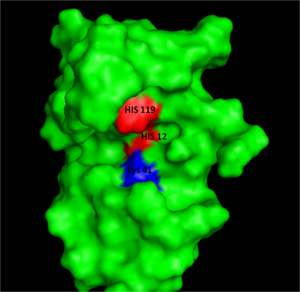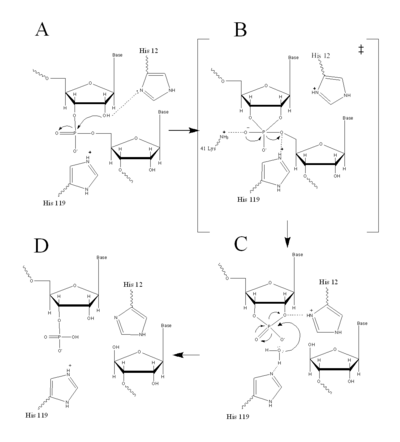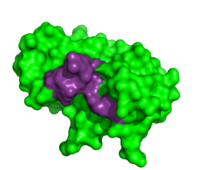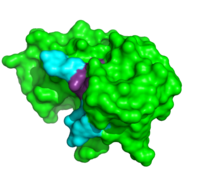RNase A
From Proteopedia
(Difference between revisions)
| (16 intermediate revisions not shown.) | |||
| Line 1: | Line 1: | ||
| + | {{BAMBED | ||
| + | |DATE=October 8, 2011 | ||
| + | |OLDID=1304330 | ||
| + | |BAMBEDDOI=10.1002/bmb.20568 | ||
| + | }} | ||
| + | <StructureSection | PDB=7RSA | Size =500 | Side=right | scene ='Sandbox_Reserved_193/Rnasei_a/1' | caption='Bovine Pancreatic Ribonuclease A (RNase A), [[7rsa]]'>__NoTOC__ | ||
== '''Introduction''' == | == '''Introduction''' == | ||
[[Image:RNaseAIII.png|300px|left|thumb|Figure I: Bovine Ribonuclease A. Colored residues are representative of amino acids important to both the acid base catalysis (Red: His12 and 119) and stabilization of the transition state (Blue: Lys41). Figure generated via ''Pymol'' ]] | [[Image:RNaseAIII.png|300px|left|thumb|Figure I: Bovine Ribonuclease A. Colored residues are representative of amino acids important to both the acid base catalysis (Red: His12 and 119) and stabilization of the transition state (Blue: Lys41). Figure generated via ''Pymol'' ]] | ||
| - | + | {{Clear}} | |
Ribonucleases or RNA depolymerases are enzymes that catalyze RNA degradation.<ref name="Raines"> PMID:11848924</ref> Ribonucleases are highly active in ruminants, such as cows, to digest large amounts of RNA produced by microorganisms in the stomach. Ruminants also have high amounts of ribonucleases to process nutrients from cellulose. One such ribonuclease, bovine pancreatic ribonuclease A or RNase A, was one of the most studied enzymes of the 20th century and was used as a model enzyme for many important findings in molecular science. <ref name="Raines" /> RNase A has been used as a foundational enzyme for the study of protein structure and function, molecular evolution, enzymatic catalysis, protein folding, protein semisynthesis, protein NMR spectroscropy, and protein oligomerization. RNase A is amenable to all of these areas due to its stability, small size, and because the three-dimensional structure is fully determined by its amino acid sequence.<ref name="Raines" /> | Ribonucleases or RNA depolymerases are enzymes that catalyze RNA degradation.<ref name="Raines"> PMID:11848924</ref> Ribonucleases are highly active in ruminants, such as cows, to digest large amounts of RNA produced by microorganisms in the stomach. Ruminants also have high amounts of ribonucleases to process nutrients from cellulose. One such ribonuclease, bovine pancreatic ribonuclease A or RNase A, was one of the most studied enzymes of the 20th century and was used as a model enzyme for many important findings in molecular science. <ref name="Raines" /> RNase A has been used as a foundational enzyme for the study of protein structure and function, molecular evolution, enzymatic catalysis, protein folding, protein semisynthesis, protein NMR spectroscropy, and protein oligomerization. RNase A is amenable to all of these areas due to its stability, small size, and because the three-dimensional structure is fully determined by its amino acid sequence.<ref name="Raines" /> | ||
| Line 9: | Line 15: | ||
=='''Structure, Catalysis, and Substrate Binding'''== | =='''Structure, Catalysis, and Substrate Binding'''== | ||
| - | + | ||
=='''Structure'''== | =='''Structure'''== | ||
| - | RNase A is made up of a single polypeptide chain of 124 residues. Of the 20 natural amino acids, RNase A possesses 19 of them, excluding tryptophan.<ref name="Raines" /> This single polypeptide chain is cross-linked internally by four disulfide linkages, which contribute to the stability of RNase A. Long four-stranded anti-parallel <scene name='Sandbox_Reserved_192/Beta_sheet/4'>ß-sheets</scene> and three short <scene name='Sandbox_Reserved_192/Alpha_helices/2'>α-helices</scene> make up the <scene name='Sandbox_Reserved_192/Secondary_structure/3'>secondary structure</scene> of RNase A.<ref name="Raines" /> The amino acid sequence was discovered to determine the three-dimensional structure of RNase A by Christian Anfinsen in the 1950s. Urea was used to denature RNase A, and mercaptoethanol was used to reduce and cleave the four disulfide bonds in RNase A to yield eight Cys residues. Catalytic activity was lost due to denaturation. When the urea and mercaptoethanol were removed, the denatured ribonuclease refolded spontaneously into its correct tertiary structure with restoration of its catalytic activity. Disulfide bonds were also reformed in the same position. The Anfinsen experiment provided evidence that the amino acid sequence contained all the information required for the protein to fold into its native three-dimensional structure. Anfinsen received the 1972 Nobel Prize in Chemistry for his work with RNase A. Nevertheless, ensuing work showed some proteins require further assistance, such as molecular chaperones, to fold into their native structure.<ref name="Lehninger" /> | + | RNase A is made up of a single polypeptide chain of 124 residues. Of the 20 natural amino acids, RNase A possesses 19 of them, excluding tryptophan.<ref name="Raines" /> This single polypeptide chain is cross-linked internally by four disulfide linkages, which contribute to the stability of RNase A. Long four-stranded anti-parallel <scene name='Sandbox_Reserved_192/Beta_sheet/4'>ß-sheets</scene> and three short <scene name='Sandbox_Reserved_192/Alpha_helices/2'>α-helices</scene> make up the <scene name='Sandbox_Reserved_192/Secondary_structure/3'>secondary structure</scene> of RNase A.<ref name="Raines" /> The amino acid sequence was discovered to determine the three-dimensional structure of RNase A by Christian Anfinsen in the 1950s. Urea was used to denature RNase A, and mercaptoethanol was used to reduce and cleave the four disulfide bonds in RNase A to yield <jmol><jmolLink> |
| + | <script> select CYS and sidechain; spacefill 100%; wireframe 0.3; color CPK | ||
| + | </script> | ||
| + | <text>eight Cys</text> | ||
| + | </jmolLink></jmol> residues. Catalytic activity was lost due to denaturation. When the urea and mercaptoethanol were removed, the denatured ribonuclease refolded spontaneously into its correct tertiary structure with restoration of its catalytic activity. Disulfide bonds were also reformed in the same position. The Anfinsen experiment provided evidence that the amino acid sequence contained all the information required for the protein to fold into its native three-dimensional structure. Anfinsen received the 1972 Nobel Prize in Chemistry for his work with RNase A. Nevertheless, ensuing work showed some proteins require further assistance, such as molecular chaperones, to fold into their native structure.<ref name="Lehninger" /> | ||
For a full list of protein structures related to RNase A, see [http://www.proteopedia.org/wiki/index.php/Category:Pancreatic_ribonuclease Pancreatic Ribonucleases]. | For a full list of protein structures related to RNase A, see [http://www.proteopedia.org/wiki/index.php/Category:Pancreatic_ribonuclease Pancreatic Ribonucleases]. | ||
| Line 22: | Line 32: | ||
==='''Active Site Structure'''=== | ==='''Active Site Structure'''=== | ||
| - | [[Image:MechIII.png| | + | [[Image:MechIII.png|400px|left|thumb|Figure II: RNase A Catalysis. (A) Initial attack of 2'hydroxyl stabilized by His12. (B) Pentavalent phosphorous intermediate. (C) 2'3' cyclic intermediate degradation. (D) Finished products: Two distinctive nucleotide sequences. Figure generated via ''Chemdraw'']] |
| + | {{Clear}} | ||
| + | RNase A uses acid/base catlysis to speed up RNA hydrolysis. This occurs in the <scene name='Sandbox_Reserved_193/Active_site_a/1'>active site</scene> which is found in the cleft of RNase A and is the location of the chemical change in bound substrates. Subsites lining the active site cleft are important to the binding of single stranded RNA. Large quantities of positively charged residues, such as <scene name='Sandbox_Reserved_193/Lys7_arg10_arg39_lys41_lys66/1'>Lys7, Arg10, Arg39, and Lys41, and Lys66</scene>, recognize the negative charge on the phosphate back bone of the <scene name='44/449690/Cv/1'>RNA strand</scene> <ref name="Wlodrawer" />. | ||
| - | The active site for RNase A, although fairly nonspecific, has some specificity for sites RNA hydrolysis. <scene name=' | + | The active site for RNase A, although fairly nonspecific, has some specificity for sites RNA hydrolysis. <scene name='44/449690/Cv/2'>Threonine 45</scene>, located next to the active site, will hydrogen bond to pyrimidine bases, but sterically hinder the binding of a purine on the 5' strand of OH. Thr45 significantly decreases the rate of hydrolysis of polymeric purine strands, such as poly A, by a thousand fold, as compared to polymeric pyrimidine strands.<ref name = 'Wlodrawer'>PMID:3401445</ref> |
Early studies on RNase A catalysis showed that alkylation of His12 and His119 significantly decreased its catalytic activity, prompting the hypothesis that these two histidines were the acid/base catalyst. Confirmation of this hypothesis came when these histidines were replaced with alanine and the reaction rates of either mutation dropped by ten-thousand fold <ref name="Wlodrawer" />. | Early studies on RNase A catalysis showed that alkylation of His12 and His119 significantly decreased its catalytic activity, prompting the hypothesis that these two histidines were the acid/base catalyst. Confirmation of this hypothesis came when these histidines were replaced with alanine and the reaction rates of either mutation dropped by ten-thousand fold <ref name="Wlodrawer" />. | ||
| Line 35: | Line 47: | ||
==='''Acid Base Catalysis by RNase A'''=== | ==='''Acid Base Catalysis by RNase A'''=== | ||
| - | RNase A catalyzes the cleavage of the Phosphodiester bonds in two steps: the formation of the pentavalent phosphate transition state and subsequent degradation of the 2’3’ cyclic phosphate intermediate using three main catalytic residues (<scene name=' | + | RNase A catalyzes the cleavage of the Phosphodiester bonds in two steps: the formation of the pentavalent phosphate transition state and subsequent degradation of the 2’3’ cyclic phosphate intermediate using three main catalytic residues (<scene name='44/449690/Cv/3'>His12, Lys41, and His119</scene> and <scene name='44/449690/Cv/4'>His12, Lys41, and His119 with substrate present</scene>). An important part of the reaction is the ability of histidine (His 12 and His119) to both accept and donate electrons, allowing these histidine to be an acid or a base, making the reaction pH dependent <ref name="Raines" />. |
| - | RNA hydrolysis begins when <scene name=' | + | RNA hydrolysis begins when <scene name='44/449690/Cv/5'>His12</scene> abstracts a proton from the 2’ OH group on RNA; thus, assisting in the nucleophilic attack of the 2’ oxygen on the electrophilic phosphorus atom. A transition state is then formed, having a pentavalent phosphate, which is stabilized by the positively charged amino group of <scene name='44/449690/Cv/6'>Lys41</scene> and the main chain amide nitrogen of Phe120. <scene name='44/449690/Cv/7'>His119</scene> then protonates the 5' oxygen on the ribose ring and the transition state falls to form a 2’3’cyclic phosphate intermediate <ref name="Raines" />. |
In a secondary and separate reaction, the 2’,3’ cyclic phosphate is hydrolyzed to a mixture of 2'phosphate and 3' hydroxyl. His12 donates a proton to the leaving group of this reaction, the 3’ oxygen of the cyclic intermediate. Simultaneously, His-119 abstracts the proton from a water molecule, activating it for nucleophilic attack. The activated water molecule attacks the cyclic phosphate causing the cleavage of the 2'3’ cyclic phosphate intermediate. The truncated nucleotide is then released with a 3’ phosphate group <ref name="Raines" />. | In a secondary and separate reaction, the 2’,3’ cyclic phosphate is hydrolyzed to a mixture of 2'phosphate and 3' hydroxyl. His12 donates a proton to the leaving group of this reaction, the 3’ oxygen of the cyclic intermediate. Simultaneously, His-119 abstracts the proton from a water molecule, activating it for nucleophilic attack. The activated water molecule attacks the cyclic phosphate causing the cleavage of the 2'3’ cyclic phosphate intermediate. The truncated nucleotide is then released with a 3’ phosphate group <ref name="Raines" />. | ||
| Line 44: | Line 56: | ||
[[Image:1RTAnew.png|thumb|left|200px|Thymidylic acid tetramer complexed with ribonuclease A]] | [[Image:1RTAnew.png|thumb|left|200px|Thymidylic acid tetramer complexed with ribonuclease A]] | ||
| - | + | {{Clear}} | |
| - | To determine the structural characteristics of RNA substrate binding to RNase A, X-ray crystallography was used to image inhibitory DNA tetramers bound to RNase A. DNA lacks the 2’OH essential to RNA cleavage, making the complex more conducive to crystallography. <scene name=' | + | To determine the structural characteristics of RNA substrate binding to RNase A, X-ray crystallography was used to image inhibitory DNA tetramers bound to RNase A. DNA lacks the 2’OH essential to RNA cleavage, making the complex more conducive to crystallography. <scene name='44/449690/Cv/8'>The complex</scene> between RNase A and <scene name='44/449690/Cv/9'>thymidylic acid tetramer (d(pT)4)</scene> ([[1rta]]) provides information about specificity of the binding pocket subunits, B0, B1, B2 and B3. Many interactions observed in this complex occur between amino acid residues and the nucleic acid backbone. Examples of these interactions include hydrogen bonding between <scene name='44/449690/Cv/10'>phosphate of T1 and Arg39</scene> as well as hydrogen bonding between the O5’ oxygen of the ribose of <scene name='44/449690/Cv/12'>T3 and Lys41</scene>. <ref>PMID:1429575</ref> |
[[Image:1RCNnew.png|thumb|left|200px|ApTpApApG complexed with ribonuclease A]] | [[Image:1RCNnew.png|thumb|left|200px|ApTpApApG complexed with ribonuclease A]] | ||
| + | {{Clear}} | ||
| + | Further binding pocket characterization was performed using <scene name='44/449690/Cv/13'>RNase A complexed with the oligonucleotide d(ApTpApApG)</scene> ([[1rcn]]). This <scene name='44/449690/Cv/14'>tetramer</scene> is closely positioned with the catalytic residues, <scene name='44/449690/Cv/15'>His12, Lys41, and His119</scene> and was important in determining the specificity of the binding sites of RNase A. In this complex, the B1 site is thought to exclusively bind to pyrimidine bases due to steric interactions and <scene name='44/449690/Cv/16'>hydrogen bonding to Thr45</scene>. When Thr45 was mutated to glycine, purines readily bound to the B1 site. <ref>PMID: 8193116</ref> This interaction appears to be the driving force behind its inability to bind purines. While binding of other nucleobases to the B2 and B3 sites is possible, the imaging of this complex elucidated the preferences for adenosine bases at these two positions. In addition to its catalytic activity His119 has also been shown to be important in substrate specificity. This is due to the <scene name='44/449690/Cv/17'>pi stacking between His119 and A3 </scene>. When this site was mutated, the affinity for a poly(A) substrate was decreased by 104-fold. <ref>PMID: 21391696</ref> It also establishes hydrogen bonding between <scene name='44/449690/Cv/18'>Asn71-A3, Gln69-A3 and Gln69-A4</scene>. <ref>PMID:8063789</ref> | ||
| - | + | From the studies on RNase A complexes with deoxy nucleic acid tetramers, it has been established that this enzyme recognizes the substrate on both its phosphate backbone and on individual nucleobases. RNase A has a nonspecific B0 site, a B1 site specific to pyrimidines and a B3 and B4 site with a preference for adenosine bases. Similar to other enzymes, RNase A uses the hydrogen bonding distance between amino acids and the substrate to bind specifically to certain nucleobases. Studying the substrate recognition and specificity of enzymes such as RNase A is an important step in understanding the regulation of RNA within biological systems. | |
| - | From the studies on RNase A complexes with deoxy nucleic acid tetramers, it has been established that this enzyme recognizes the substrate on both its phosphate backbone and on individual nucleobases. RNase A has a nonspecific B0 site, a B1 site specific to pyrimidines and a B3 and B4 site with a preference for adenosine bases. Similar to other enzymes, RNase A uses the hydrogen bonding distance between amino acids and the substrate to bind specifically to certain nucleobases. Studying the substrate recognition and specificity of enzymes such as RNase A is an important step in understanding the regulation of RNA within biological systems. | ||
| - | </StructureSection> | ||
=='''Inhibitors'''== | =='''Inhibitors'''== | ||
| - | + | <scene name='User:R._Jeremy_Johnson/RNaseA/Ri_rnasea_simple/1'>inhibitor (RI) (tan) bound to RNase A (red)</scene> ([[1dfj]]). | |
| - | < | + | |
| - | + | ||
| - | + | ||
| - | + | ||
| - | + | ||
| + | Due to the high rate of RNA hydrolysis by RNase A, mammalian cells have developed a protective inhibitor to prevent pancreatic ribonucleases from degrading cystolic RNA. Ribonuclease Inhibitor (RI) tightly associates to the active site of RNase A due to its <scene name='User:R._Jeremy_Johnson/RNaseA/Ri_simple/1'>non-globular nature</scene>. RI is a 50 kD protein that is composed of 16 repeating subunits of alpha helices and beta sheets, giving it a noticeable <scene name='User:R._Jeremy_Johnson/RNaseA/Ri_nonglobular/1'>horseshoe like appearance</scene>. The RI-RNase protein-protein interaction has the highest known affinity of any protein-protein interactions with an approximate dissociation constant (''K''d) of 5.8 X 10-14 for almost all types of ribonucleases.<ref>PMID:7877692</ref> The ability to be selective for almost all types of RNases, and yet retain such a high Kd is product of its mechanism of inhibition. The interior residues of the horseshoe shaped RI are able to bind to the charged residues of the active site cleft of RNase A, such as <scene name='44/449690/Cv/19'>Lys7, Gln11, and Lys41 </scene>. By studying the amphibian RNase, Onconase, the residues Lys7 and Gln11 of RNase A were shown to be the most important in this interaction. In onconase, these residues are replaced with non-charged amino acids, which help prevent the binding of RI to the protein <ref>PMID:18930025</ref> | ||
| + | </StructureSection> | ||
| + | __NOTOC__ | ||
=='''Additional Proteopedia Pages about RNase A'''== | =='''Additional Proteopedia Pages about RNase A'''== | ||
| Line 91: | Line 101: | ||
* [http://www.proteopedia.org/wiki/index.php/User:Grace_Douglass Mary Andorfer, Grace Douglass, and Laurel Heckman] | * [http://www.proteopedia.org/wiki/index.php/User:Grace_Douglass Mary Andorfer, Grace Douglass, and Laurel Heckman] | ||
* [http://www.proteopedia.org/wiki/index.php/User:Lauren_Garnett Lauren Garnett and Micah Raebel] | * [http://www.proteopedia.org/wiki/index.php/User:Lauren_Garnett Lauren Garnett and Micah Raebel] | ||
| + | |||
| + | [[Category:Featured in BAMBED]] | ||
Current revision
This page, as it appeared on October 8, 2011, was featured in this article in the journal Biochemistry and Molecular Biology Education.
| |||||||||||
Additional Proteopedia Pages about RNase A
3D structures of ribonuclease
References
- ↑ 1.0 1.1 1.2 1.3 1.4 1.5 1.6 1.7 1.8 1.9 Raines RT. Ribonuclease A. Chem Rev. 1998 May 7;98(3):1045-1066. PMID:11848924
- ↑ Avey HP, Boles MO, Carlisle CH, Evans SA, Morris SJ, Palmer RA, Woolhouse BA, Shall S. Structure of ribonuclease. Nature. 1967 Feb 11;213(5076):557-62. PMID:6032249
- ↑ Wyckoff HW, Hardman KD, Allewell NM, Inagami T, Johnson LN, Richards FM. The structure of ribonuclease-S at 3.5 A resolution. J Biol Chem. 1967 Sep 10;242(17):3984-8. PMID:6037556
- ↑ Greenway MJ, Andersen PM, Russ C, Ennis S, Cashman S, Donaghy C, Patterson V, Swingler R, Kieran D, Prehn J, Morrison KE, Green A, Acharya KR, Brown RH Jr, Hardiman O. ANG mutations segregate with familial and 'sporadic' amyotrophic lateral sclerosis. Nat Genet. 2006 Apr;38(4):411-3. Epub 2006 Feb 26. PMID:16501576 doi:10.1038/ng1742
- ↑ 5.0 5.1 5.2 'Lehninger A., Nelson D.N, & Cox M.M. (2008) Lehninger Principles of Biochemistry. W. H. Freeman, fifth edition.'
- ↑ 6.0 6.1 6.2 Wlodawer A, Svensson LA, Sjolin L, Gilliland GL. Structure of phosphate-free ribonuclease A refined at 1.26 A. Biochemistry. 1988 Apr 19;27(8):2705-17. PMID:3401445
- ↑ Birdsall DL, McPherson A. Crystal structure disposition of thymidylic acid tetramer in complex with ribonuclease A. J Biol Chem. 1992 Nov 5;267(31):22230-6. PMID:1429575
- ↑ delCardayre SB, Raines RT. Structural determinants of enzymatic processivity. Biochemistry. 1994 May 24;33(20):6031-7. PMID:8193116
- ↑ Thompson JE, Raines RT. Value of general Acid-base catalysis to ribonuclease a. J Am Chem Soc. 1994 Jun;116(12):5467-8. PMID:21391696 doi:10.1021/ja00091a060
- ↑ Fontecilla-Camps JC, de Llorens R, le Du MH, Cuchillo CM. Crystal structure of ribonuclease A.d(ApTpApApG) complex. Direct evidence for extended substrate recognition. J Biol Chem. 1994 Aug 26;269(34):21526-31. PMID:8063789
- ↑ Kobe B, Deisenhofer J. A structural basis of the interactions between leucine-rich repeats and protein ligands. Nature. 1995 Mar 9;374(6518):183-6. PMID:7877692 doi:http://dx.doi.org/10.1038/374183a0
- ↑ Turcotte RF, Raines RT. Interaction of onconase with the human ribonuclease inhibitor protein. Biochem Biophys Res Commun. 2008 Dec 12;377(2):512-4. Epub 2008 Oct 16. PMID:18930025 doi:10.1016/j.bbrc.2008.10.032
External Resources
- Full crystal structure of 1RTA
- Full crystal structure of 1RCN
- Further information on 1RTA
- RNase A- Molecule of the Month
- RNase A-Wikipedia
- Ribonuclease Inhibitor-Wikipedia
- Ribonuclease-Wikipedia
- Ruminants-Wikipedia
Student Contributors
- Nathan Clarke and Kristyn Shaw
- Mary Andorfer, Grace Douglass, and Laurel Heckman
- Lauren Garnett and Micah Raebel
Proteopedia Page Contributors and Editors (what is this?)
Alexander Berchansky, R. Jeremy Johnson, Karsten Theis, Angel Herraez, Michal Harel




